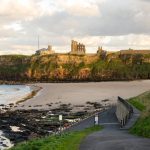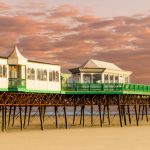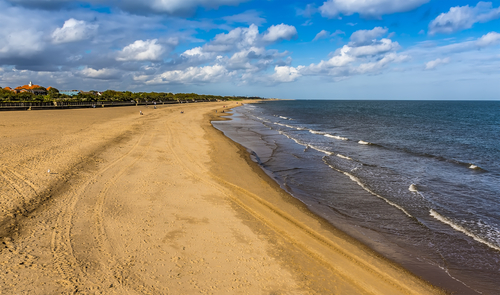
Skegness is a town, quintessential seaside resort and civil parish on the Lincolnshire coast. The town is situated on the east coast of England facing the North Sea, about 5 miles north of the mouth of ‘The Wash’. The town also lies about 43 miles (69 km) east of Lincoln and 22 miles (35 km) north-east of Boston. Skegness is often referred to as ‘Skeggy’ not only locally but throughout much of the country.
A Fleeting History

”Skegness” is derived from Old Norse
There is archaeological evidence to suggest there was late Iron-Age settlement in the Skegness area. It’s thought early Roman settlement followed, where the inhabitants were largely involved in salt panning. There is also a documented narrative that promotes the notion that a Roman fort existed in the town up until the late Middle Ages but was then lost to the sea during a massive storm. It has also been suggested that Skegness was both the terminus of a Roman road running from Lincoln and a ferry port, that connected with Norfolk across ‘The Wash’.
While it seems likely that the Anglo-Saxons would have settled in the Skegness area following their mid-5th century invasion of that part of England, there is no actual evidence to date to support the theory. However, the invading 9th-century Vikings certainly did settle in Skegness as their influence can be found in the town’s designation. The name of Skegness is derived from the Old Norse words of ‘Skeggi’ and ‘ness’, translating as “Skeggi’s headland”. Where Skeggi, meaning ” the bearded one” would have been the name of a Viking settler. Alternatively, it’s thought the name could simply be derived from the word ‘skegg’ meaning “beard”, which could have described the ‘beard-shaped’ headland.
Missing From the Doomsday Book
While there are no entries of ‘Skegness’ in the Domesday Book of 1086, the settlement has been linked with those for ‘Tric’, whose location hasn’t been positively identified. Some experts have argued that the name Tric is derived from the Latin word for “crossing”, which gives credence to the Roman ferry port theory. The name Skegness first appears in writing in the 12th century, with further known references being made in the following century. Poll tax records showed that 140 people, over the age of 14, were then living in the Skegness area in 1377. However, by that time, Skegness, along with several other local coastal settlements was beginning to experience major land loss because of rising sea levels. In 1526, this culminated in most of Skegness being washed away during an exceptional storm. In 1543, notable traveller, poet and antiquarian, John Leland visited the town, noting that; (sic) “For old Skegnes is now buildid a pore new thing”. In 1563, it was documented that Skegness consisted of just 14 households. Some 140 years later, according to records, the number had reduced to only 10 families residing in the area.
Skegness Becomes Fashionable
By the late 18th century, the local well-to-do had started visiting the village of Skegness for health reasons. It was at this time that the medical profession began promoting the notion that sea air brought health benefits. In 1770, to cash-in on the growing trend, the newly built Skegness Hotel opened its doors to the public. In 1784, a written reference to bathing machines being at Skegness was made, though it’s thought they were probably there even earlier. More hotels were soon built, and private houses began opening their doors to lodgers – the town’s first guesthouses. While attending boarding school in nearby Lough (1816 to 1820), a young Alfred Tennyson became a frequent visitor to Skegness.
The Railway Arrives
In 1871, the population of Skegness was still only 349, where most people were still employed in farming and/or fishing. However, things were about to change dramatically for the town. In 1873, Great Northern Railways (GNR) extended their branch line from Grimsby all the way through to Skegness. The much greater connectivity meant that that visitors soon began arriving to the town in much greater numbers. The line was essentially designed to bring day-trippers from the East Midlands to the seaside. Rising wages and better holiday provision meant that the working-classes from towns like Nottingham, Derby and Leicester could now afford to take their first holiday, even if it was just for a day.
With agriculture in depression, the local major landowner Richard Lumley, 9th Earl of Scarbrough, had seen his rental income from land sharply decline. Following financial advice, Lumbley decided to pour his economic resources into the development of Skegness as a tourist resort. Thus, in 1881, Skegness Pier and the Pleasure Gardens opened. And, in 1883, new steamboats began operating from the pier to take visitors for cruises across ‘The Wash’. Also in 1883, a new bathing pool opened. The Earl also donated land and money towards the building of St Matthew’s Church, two Methodist chapels, a school, and a cricket ground. Lumbley then had plans drawn up for the construction of almost 800 houses, though he left the actual building to speculative developers. Thus, by 1881, the town’s population had increased to 1,338, representing a rise of almost 400% in ten years. The August Bank Holiday of 1882 saw more than 20,000 visitors descend on the town.
The Council Is Formed
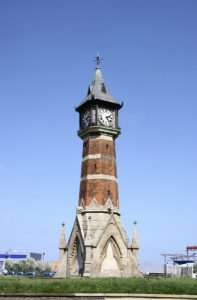
The Diamond Jubilee Clock Tower was built in 1889
In 1895, the Skegness Urban District Council was formed, which would oversee a boom time for the resort that would last for the next 50 years. The turn of the century saw the construction of holiday camps, holiday homes, theatres, pubs, and cinemas, as well as the latest in fairground amusements and attractions. The resort’s reputation was now such, that in 1913, more than three-quarters of a million people chose to visit the town.
The town’s popularity as a tourist destination did not diminish during WW1 and continued to positively flourish during the interwar years. In 1922, the urban district council purchased the seafront from the 10th Earl of Scarbrough, Aldred Lumley. The authority embarked on a programme of construction, which saw the opening of the Tower Esplanade in 1923; the Boating Lake in 1924; the Fairy Dell paddling pool, the Embassy Ballroom and an outdoor swimming pool in 1928; and major remodelling of parts of the foreshore in 1931.
The Roaring Twenties
In the late 1920s, future hotelier Billy Butlin, who had earlier worked in the Skegness as a beach stall holder, decided to build a permanent amusements complex in the resort. The park opened in 1929 to great success. In 1932, Butlin organised the town’s first illuminations display, and the following year, launched the town’s inaugural carnival. In 1936, the very first Butlin’s holiday camp was built at Ingoldmells. When it opened, it uniquely provided all food, facilities and a stream of entertainment, for its guests. It was also during the 1930s that North Parade saw the building of numerous hotels. The 1920s also saw the development of both private and council residential property. Thus, in the two decades between 1911 and 1931, the town’s population increased from 3,775 to 9,122.
During WW2, the RAF’S No 11 Recruit Centre was established close to Skegness, which saw thousands of trainees being billeted in the town. The Butlin’s Camp was commandeered by the Royal Navy. Renamed HMS Royal Arthur, it became a training centre for would-be sailors. Aerial bombing of the town by the Luftwaffe began in 1940, where several fatalities on several separate occasions where experienced. The greatest loss of life came on 24 October 1941 when 12 residents were killed during a single raid.
The Modern Era
After WW2, self-catering type holidays become popular in the UK, which has saw a huge growth in caravan parks and chalet accommodation in the Skegness area. Consequently, many of the commercial lodgings in the town closed down and the buildings converted to residential property or shops. However, the 1970s, also saw the advent of the cheap package holiday to Europe, which took huge amounts of visitors away from British seaside resorts. The 1980s saw a sharp decline of coal mining in the East Midlands. Thus, the loss of families who had traditionally holidayed in the town, also contributed to declining tourist numbers. Nevertheless, the town faired better than many of its seaside counterparts, as tourist numbers were shored up to some degree by winter visits from the elderly. Like most towns, Skegness has a mixture of bespoke independent shops and branches of national chain outlets. However, Hildred’s Shopping Centre, located right in the middle of Skegness, is the area’s main retail complex.
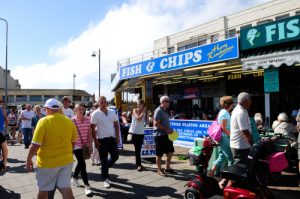
*Skegness’ visitor numbers remain relatively high
Today, Skegnessis home to around 19,579 and 24,876 throughout the wider urbanised area and remains one of the most popular holiday resorts in the UK. In 2013, it was reported that the town receives some 4 millions visits per year including day-trippers. This accounts for £480 million of the local economy. The town thus “heavily reliant” on tourism.
Getting To Skegness!
By Road
From the North and Midlands, the easiest way to Skegness is probably via the A1/A1(M). From there turn off and follow the A57 to towards Lincoln, then follow the A158 all the way to Skegness. From the Humberside area take the A16 and then the A1028. From the South, take the M1, turn off at Nottingham onto the A52, and then follow all the way into Skegness.
By Train
Skegness is connected to London’s King’s Cross and St Pancras via Nottingham. The journey time between Skegness and Nottingham is 2 hours 15 mins. From most other major destinations, you will need to catch a train to Grantham. Trains are hourly, with the journey taking about 90 minutes.
By Bus
National Express run 3 coaches daily from Golders Green, that also stop at London Victoria, directly to Skegness. Getting to Skegness by coach from other parts of the country will probably mean making at least one, if not two, changes.
By Air
Humberside Airport is 16 miles (26 km) away but there are few scheduled flights so Manchester International Airport would be your best bet if flying in. It may be 130 miles (208 km) away but there are plenty of trains. Mind you there will be a few changes involved including at Doncaster, and Grantham.
Things to do and see
There’s a good assortment of things to see and do in and around Skegness. Some of the recommendations are:
- Skegness Pier – was originally built in 1881 but has since been refurbished and shortened from 500 m to 118 m. The pier offers a soft play area, trampolines for children and an amusement arcade.
- Natureland Seal Sanctuary – is primarily a rehabilitation centre for seals but the site has plenty of other animals such as alpacas, penguins and meerkats, as well as an array of farmyard animals. There’s also a tropical house where you’ll find crocodiles, snakes and scorpions.
- Diamond Jubilee Clock Tower – was built in 1899 to mark Queen Victoria’s Diamond Jubilee. The Neo-Gothic clock tower is arguably the resort’s most iconic landmark.
- The Village Church Farm – is the only open-air farm museum in Lincolnshire. There’s a preserved 18th farmhouse, exhibitions on rural domestic covering the past 200 years and displays of related machinery and tools. There’s also a tea room as well as weekly held activities such as archery and painting classes.
- Skegness Aquarium – has a pirate theme to make it appealing to kids. The quiz trail is intended to keep their interest. Davy Jones’ Locker is an underwater tunnel where sharks and rays can be viewed. In between the different displays, there are interactive stations with various activities.
- Skegness Model Village – is an idealised English village, set out with shops, houses and a church. It has hundreds of little figures modelled to look as if they are going about their daily business. It also has a fairground that has moving rides.

Skegness Pier on a cool summer’s evening Image: Tom Richo/Shutterstock.com
Out and About
If you are keener on the great outdoors then consider…
- Skegness Beaches – holds both ”Blue Flag” and ”Quality Coast Award” certification. The immaculate beaches are some of the best in the UK and offer an unbroken belt of golden sands.
- Visit Gumby Hall – is located 10 minutes from Skegness on the edge of the Lincolnshire Wolds. It’s a Grade I listed country mansion, built around 1700, run by the National Trust. It was the ancestral home of the Massingberd family, who lived there from 1700 to 1967. Thus, the house is stuffed with their artefacts but there’s also pristine clipped gardens, wildflower walks, a canal, and a walled kitchen garden. And, of course, there is a tea-room!
- Take a short trip to the village of Ingoldmells where you will find Fantasy Island Theme Park – a traditional amusement and adventure complex. There are exhilarating rides and roller coasters for young thrill-seekers. It’s also home to Europe’s largest 7-day market, and there’s plenty of restaurants, cafes and bars, situated throughout the park.
- Go Horse riding – there are 4 such centres within a few minutes of Skegness. They can provide lessons for newcomers right up to a bit of a gallop for the old hands. For the suitably experienced, Orchard Farm Riding Centre, 15 minutes from Skegness, offers a whole day ride into the Lincolnshire Wolds!
- The North Sea Observatory – is UK’s only purpose-built marine observatory. Located at Chapel Point, a few miles north of Skegness, the building is open all-year-round. The complex includes the Seascape Cafe, an art gallery, which opens for exhibitions and workshops, and exhibits relating to local natural history.
Sport In Skegness
Football
Skegness Town AFC currently (2020/21) currently competes in the Northern Counties East League Division 1. Nicknamed ‘The Lilywhites’, they play their homes games at the Vertigo Stadium.
Rugby
Skegness RUFC’s first XV currently (202o/21) play their rugby in the Midlands 4 East (North) League. They play their home games at ‘The Pavilion’, Wainfleet Road.
Cricket
Skegness CC first XI currently (2020) play in the South Lincolnshire and Border Premier League. The club’s base since 1877, they play their home games at Richmond Drive. A ladies hockey team and a squash team also operate from the complex.
Golf
If you fancy a quick 18 holes then you are in luck as Skegness has three courses. to choose from. The best is Seacroft Golf Club, which is often cited as being in the top 100 best courses in the country. The other 18-hole course is the North Shore Golf Club, which is a mixture of links and parkland. Cheapest is the Skegness Golf Centre, which is a nine-hole course. It also has a pro shop and a driving range.
Notable People From Skegness
A few notable people who were born in, or have a connection to Skegness, include:
- England & Liverpool Goalkeeper Ray Clemence was Skegness Born & Bred – In a poll carried out by the ‘Total Football’ magazine, he was voted the best goalkeeper of all time. He also gained 61 international caps for England.
- Dave Allen (1936 – 2005) – was a world-renowned Irish comedian, actor, social commentator, and satirist. The hugely popular but often controversial Allen had several ‘hit’ ITV and BBC shows during the 1960s and 70s. He kicked off his entertainment career working as a redcoat at Butlins in Skegness during the 1950s
- Actress Elizabeth Allan who was quite renowned in the 1930s. She is best known for starring alongside Hollywood Icon Bela Legosi in the 1935 Horror Film “Mark of The Vampire”. You can see a clip from this classic below.
Did you know?
- Ray Clemence is one of only 29 footballers in the world to surpass 1000 appearances, whilst playing top-flight football.
- Butlins Holiday Camp at Skegness, which opened in 1936, was the first such establishment in the world to offer its guests an ‘all-inclusive’ holiday.
- In 1935, a creature dubbed the “Skegness Monster” was found washed-up on the town’s beach. It reportedly had a horned beak like a parrot, while its mouth that was set in the centre of eight powerful tentacles, that were covered with horny suckers. It was concluded it was a member of the squid or octopus’ family, but the species was never determined.
- The image of Skegness’ mascot, ‘The Jolly Fisherman’, was created by artist John Hassall in 1908 to use in a railway poster to promote the town.
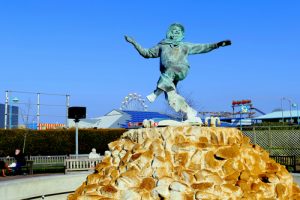
The Jolly Fisherman’ is the official mascot of Skegness Image: Oscar Johns/Shutterstock.com
Where to stay?
The local accommodation is very competitively priced. A rough guide to prices per night for 2 adults sharing:
Guesthouse/Inn/ B&B/Lodge/Small Hotel £50 – 90
Luxury Hotel: £90 – 150
There is also a good number of holiday homes, self-catering style accommodation and apartments, that have a wide price range depending on the standard and location.
Thinking of moving To Skegness?
Thinking of moving to Skegness? Properties here have sold for an overall average price of £158,400 over the last 12 months (Nov 2020). Detached houses were the best-selling property type in the town last year, selling for an average price of £196,600. Semi-detached properties sold for an average of £143,200, while terraced properties fetched £129,900. Overall property prices are down here by an average of 3% over last 12 months when compared to the previous year.

